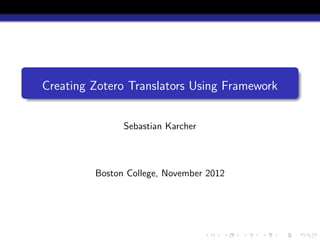Zotero Framework Translators
- 1. Creating Zotero Translators Using Framework Sebastian Karcher Boston College, November 2012
- 2. Why Learn About Translators? One-click import from the web is perhaps the key features that distinguishes Zotero In this session we will write a “screen scraper” type translator for Zotero Best Case: This will allow you to write translators for sites you or your “clients” need Minimal Case: This will give you an undertstanding on how translators work and what may be possible, even if you’re not going to do it yourself
- 3. Some Notes on Zotero Translators Each Zotero translator is an individual file, written in javascript There are four types of translators: Web, Import, Search, Export Some web translators, like those for many libraries, call on an import translators (e.g. MARC) - we won’t learn about those. Other web translators “scrape” data from the page - that is what we will do now
- 4. (I know last week was Halloween but:) This isn’t going to be scary! You cannot break Zotero by fiddling with translators - you can always “reset” from the advanced panel of the preferences About 2 years ago, Eric Hetzner of the UC libraries developed a “framework” for wrting translators –> now you don’t need any javascript. Just Xpaths and regular expressions. And those are easy!
- 5. Xpaths are “directions” on a website xpaths are basically “directions” used to point to a part of a webpage A webpage is built up from a number of nested nodes This is what the most simple webpage looks like <html> <head> <title>A Basic Webpage</title> </head> <body> <div id="title">The Title of the webpage</div> <div id="content" class="text">The Content of the w </body> </html>
- 6. The most basic Xpath Give directions: at every corner/node, tell Zotero where to go: Let’s say we want to go go to “The Content of the webpage” “Take the HTLM road, take a left at”body“, then take the”div” street, or in HTML: /html/body/div
- 7. Making Xpaths more precise But we’re still “lost” - which of the two “div” streets do we go down? Option 1: Take the second <div> /html/body/div[2] Option 2: Take the <div> that has “content” as an id /html/body/div[@id="content"]
- 8. Making Xpaths more efficient In an actual webpage, an xpath can be very long, so we’d like to make them shorter. we can use // to start anywhere in the html tree, e.g “the <div> with”content” as an “id” anywhere on the site: //div[@id="content"] Sometimes we don’t want the precise content of an attribute like id - in those case we can use contains() as in //div[contains(@id, "cont")] We can combine conditions with “and” or “or” (in lowercase!) //div[@id="content" and @class="text"]
- 9. A sample Framework Translator - Single item /** Articles */ FW.Scraper({ itemType : ’blogPost’, detect : FW.Xpath(’//h1[@class="article-title"]’), title : FW.Xpath(’//h1[@class="article-title"]’).text().tri attachments : { url : FW.Url(),title : "voxEU snapshot",type : "text/html }, creators : FW.Xpath(’//div[@class="author"] //span[@class="field-content"]/a’).text().cleanAuthor("auth abstractNote : FW.Xpath(’//div[@class="article-teaser"]’).t date : FW.Xpath(’//h1[@class="article-title"]/following-sib publicationTitle : "VoxEU.org" });
- 10. A sample Framework Translator - Multiples /** Search results */ FW.MultiScraper({ itemType : "multiple", detect : FW.Xpath(’//ul[contains(@class, "search-results")] choices : { titles : FW.Xpath(’//ul[contains(@class, "search-results")] /li/h2/a’).text(), urls : FW.Xpath(’//ul[contains(@class, "search-results")] /li/h2/a’).key(’href’).text() } });
- 11. Our Tools Scaffold - a Firefox extension to write and test the translator Firefox “Inspect Element” - to help us understand the structure of a webpage (there are alternatives like “Firebug”)






![Making Xpaths more precise
But we’re still “lost” - which of the two “div” streets do we
go down?
Option 1: Take the second <div>
/html/body/div[2]
Option 2: Take the <div> that has “content” as an id
/html/body/div[@id="content"]](https://image.slidesharecdn.com/framework-translators-121111192316-phpapp02/85/Zotero-Framework-Translators-7-320.jpg)
![Making Xpaths more efficient
In an actual webpage, an xpath can be very long, so we’d like
to make them shorter. we can use // to start anywhere in the
html tree, e.g “the <div> with”content” as an “id”
anywhere on the site:
//div[@id="content"]
Sometimes we don’t want the precise content of an attribute
like id - in those case we can use contains() as in
//div[contains(@id, "cont")]
We can combine conditions with “and” or “or” (in lowercase!)
//div[@id="content" and @class="text"]](https://image.slidesharecdn.com/framework-translators-121111192316-phpapp02/85/Zotero-Framework-Translators-8-320.jpg)
![A sample Framework Translator - Single item
/** Articles */
FW.Scraper({
itemType : ’blogPost’,
detect : FW.Xpath(’//h1[@class="article-title"]’),
title : FW.Xpath(’//h1[@class="article-title"]’).text().tri
attachments : {
url : FW.Url(),title : "voxEU snapshot",type : "text/html
},
creators : FW.Xpath(’//div[@class="author"]
//span[@class="field-content"]/a’).text().cleanAuthor("auth
abstractNote : FW.Xpath(’//div[@class="article-teaser"]’).t
date : FW.Xpath(’//h1[@class="article-title"]/following-sib
publicationTitle : "VoxEU.org"
});](https://image.slidesharecdn.com/framework-translators-121111192316-phpapp02/85/Zotero-Framework-Translators-9-320.jpg)
![A sample Framework Translator - Multiples
/** Search results */
FW.MultiScraper({
itemType : "multiple",
detect : FW.Xpath(’//ul[contains(@class, "search-results")]
choices : {
titles : FW.Xpath(’//ul[contains(@class, "search-results")]
/li/h2/a’).text(),
urls : FW.Xpath(’//ul[contains(@class, "search-results")]
/li/h2/a’).key(’href’).text()
}
});](https://image.slidesharecdn.com/framework-translators-121111192316-phpapp02/85/Zotero-Framework-Translators-10-320.jpg)
